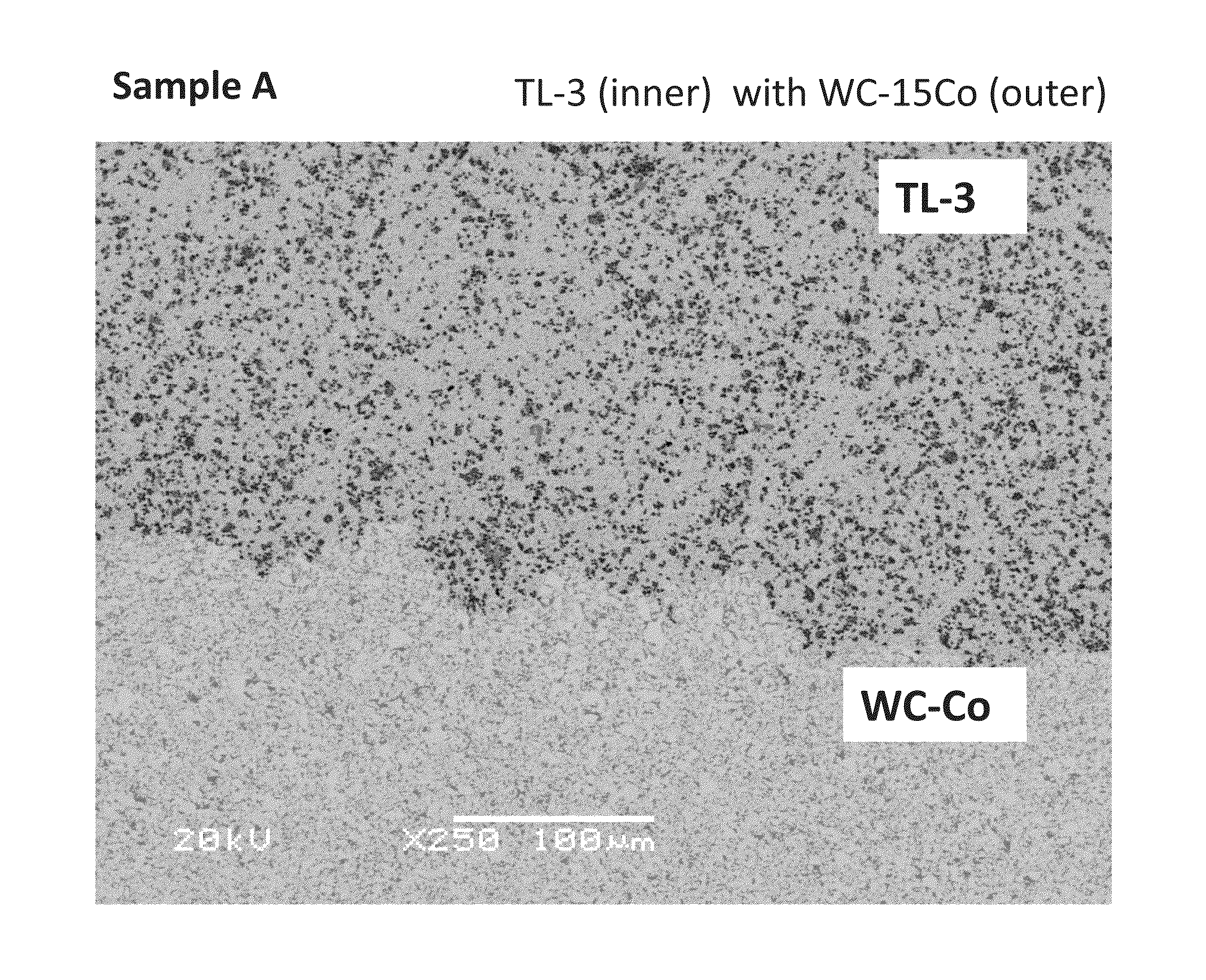Methods of forming a metallic or ceramic article having a novel composition of functionally graded material and articles containing the same
a functional graded material and composition technology, applied in metal-working apparatus, turning machines, record information storage, etc., can solve the problems of increasing limiting the use of special applications, and adding additional processes. cost and lead time,
- Summary
- Abstract
- Description
- Claims
- Application Information
AI Technical Summary
Benefits of technology
Problems solved by technology
Method used
Image
Examples
example 1
FGM Solid Rods Having Different Top and Bottom Materials
[0170]Twelve FGM two-material rods were prepared and sinter hot isostatic pressed (HIPed) according to the methods below. The rods were each comprised a top material making up ⅔ of the rod, and a bottom material making up the remaining ⅓ of the rod. Each rod made in this Example was comprised of a TCHP / WC—Co FGM Rod having a ⅜″ OD×2½″. The specific materials used for top and bottom sections were:
Top ⅔ MaterialBottom ⅓ MaterialWC-15CoTi(C, N) core TCHP TL-3
[0171]The WC—Co material used in this example comprised 3 micron nominally sized WC with 15 wt % cobalt, and exhibited the following physical properties: Hardness (ASTM B294) of 88.0, an HRA Fracture Toughness (ISO 28079) of 11.49 MPa / m, and a Density (ASTM B311) of 14.05 g / cm3.
[0172]The TL-3 had the following Physical Properties: Hardness (ASTM B294) of 92.1, an HRA Fracture Toughness (ISO 28079) of 11.43 MPa / m, and a Density (ASTM B311) of 12.75 g / cm3.
[0173]The typical Powde...
example 2
FGM Cylinders with Different Inner and Outer Materials
[0187]Four variations of FGM two-material cylinders were prepared and vacuum sintered as described herein, with the following inner and outer materials.
SampleInner MaterialOuter MaterialATi(C, N) core TCHP TL-3WC-15Co GWC-50BAl2O3 core TCHP NL-3WC-15Co GWC-50CAl2O3 core TCHP NL-3Ti(C, N) core TCHP TL-3DTi(C, N) core TCHP TL-3Al2O3 core TCHP NL-3
[0188]Typical Powder Pressing Method (for FGM Cylinders)
[0189]The following provides the methodology used for powder pressing FGM Cylinders made according to the present disclosure.
[0190]A thin-walled hollow steel tube (outer diameter 0.340″) was placed into the center of the cylindrical die tooling set (diameter 0.580″) on a conventional powder press to maintain separation during loading of the two distinct powder types (“inner” and “outer” materials).
[0191]Approximately 8 grams of TCHP “inner” powder was placed in the interior of the hollow tube, and approximately 12.5 grams of “outer” p...
PUM
| Property | Measurement | Unit |
|---|---|---|
| particle size | aaaaa | aaaaa |
| pressure | aaaaa | aaaaa |
| temperature | aaaaa | aaaaa |
Abstract
Description
Claims
Application Information
 Login to View More
Login to View More - R&D
- Intellectual Property
- Life Sciences
- Materials
- Tech Scout
- Unparalleled Data Quality
- Higher Quality Content
- 60% Fewer Hallucinations
Browse by: Latest US Patents, China's latest patents, Technical Efficacy Thesaurus, Application Domain, Technology Topic, Popular Technical Reports.
© 2025 PatSnap. All rights reserved.Legal|Privacy policy|Modern Slavery Act Transparency Statement|Sitemap|About US| Contact US: help@patsnap.com



